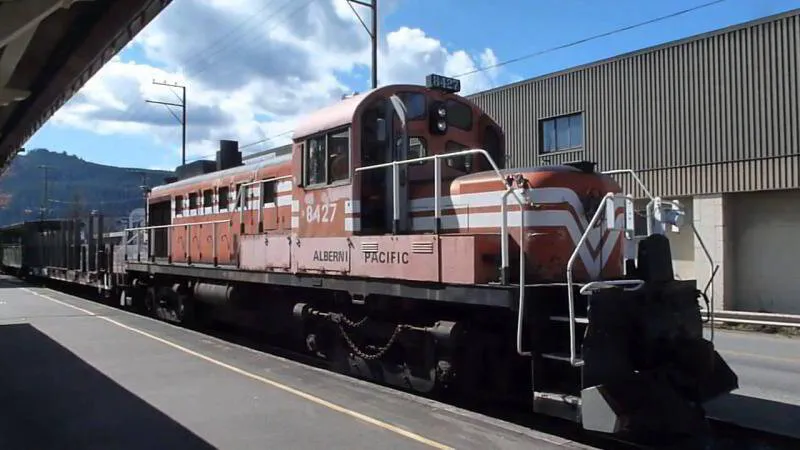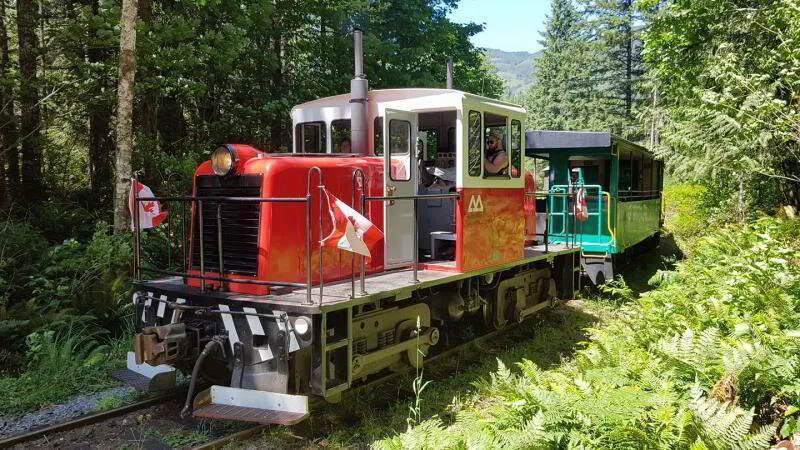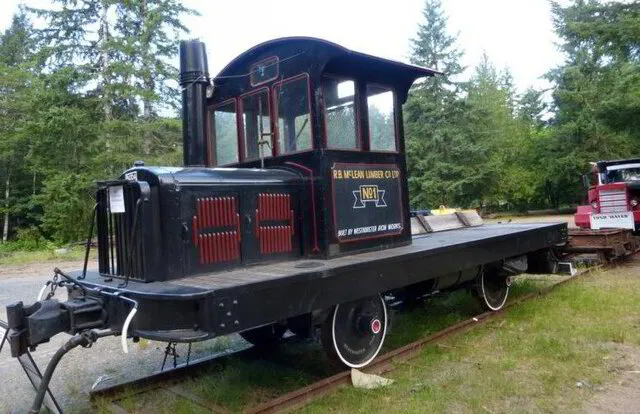The Railway
Construction began on April 30th, 1884, and on the 13th of August 1886, Prime Minister Sir John A. MacDonald drove home the last railway spike at Cliffside near Shawnigan Lake.
The Railway
Historically, the McLean Mill Historic Site has served as the destination point for the Alberni Pacific Railway (APR), an organization that has operated three different locomotives, including the favourite No.7 Baldwin Steam Locomotive built in 1929.
Unfortunately, the train isn't currently running due to funding requirements for necessary servicing costs. Our local operators are hard at work searching for parts and are working with other organizations to ensure a return to the tracks as soon as possible.
Currently, all the locomotives are being attended to and we expect to see them back on the tracks in the foreseeable future.
The Forest
The path leading from the visitor centre to the historic area goes through second growth forest that was originally logged by the McLeans in the 1920s. None of the new forest was planted. Regeneration occurred naturally. Fir and Cedar trees can be seen growing out of rotting stumps. Some of the old stumps have notches that held the springboards on which the fallers stood as they whipped their hand saws back and forth.
Railway History
The Vancouver Island Railway, first known as the Esquimalt and Nanaimo (E&N) Railway, was incorporated on the 27th of September 1883 by Victoria coal baron Robert Dunsmuir, to support the coal and lumber industry and the Royal Navy Base at Esquimalt Harbour.
Construction began on April 30th, 1884, and on the 13th of August 1886, Prime Minister Sir John A. MacDonald drove home the last railway spike at Cliffside near Shawnigan Lake. The initial rail bed extended for 115 kilometres from Esquimalt to Nanaimo; hence the original name of the company. In 1888 the line was extended to the City of Victoria.
In 1905, Robert Dunsmuir’s son James sold the railway company to the Canadian Pacific Railway (CPR) who extended it to Lake Cowichan, Port Alberni, Parksville, Qualicum Beach and, finally, Courtenay. At its peak, the E&N Railway had 45 stations on the main line and 8 on the Port Alberni line. Today, about 25 stations remain with the majority unused and in a state of disrepair.
Under CPR ownership, the Port Alberni subdivision was completed in 1912, and the Victoria sub-extension from Parksville to Courtenay was completed and opened in 1914. The total lengths of subdivisions on the E&N at its peak are as follows ~ Victoria subdivision 139.7 miles, Port Alberni subdivision 37.9 miles, Lake Cowichan subdivision 18.6 miles, Great Central Lake subdivision 10.3 miles, and Osborne Bay subdivision (later called the Crofton Spur) 2.6 miles.
– total miles of all tracks ever identified as a subdivision of the E&N Railway: 209.1 miles. This would be the all time high and remained until circa 1952 when the Great Central Lake subdivision was first removed from service and abandoned in 1953. The exact mileage the Great Central Lake subdivision came off the Port Alberni subdivision was at Mile Post 35.6 at a location called Solly Junction.
The E&N Railway was to have fulfilled the agreement which brought British Columbia into confederation, to become a Province of Canada. Although it was never completed, it was still considered a small piece of the trans-continental rail system.
In 1905, Robert Dunsmuir’s son James sold the railway company to the Canadian Pacific Railway (CPR) who extended it to Lake Cowichan, Port Alberni, Parksville, Qualicum Beach and, finally, Courtenay. At its peak, the E&N Railway had 45 stations on the main line and 8 on the Port Alberni line. Today, about 25 stations remain with the majority unused and in a state of disrepair.
In 1953, CPR discontinued passenger train operations into Port Alberni. In 1979, VIA Rail assumed operational responsibility for the remaining passenger service between Victoria and Courtenay, but CPR retained ownership. VIA provided the rolling stock, passenger subsidy and ticket sales.
Advertising was minimal so the railway was operating in isolation to the rest of Canada and North America. In 1998, CPR sold the east-west corridor between Parksvillle and Port Alberni to Rail America, and entered into an agreement to carry freight, which was taken to the barge facility at Nanaimo. At that time, approximately 8,500 carloads of forest and paper products, minerals and chemicals were transported by rail on the island each year.
More changes occurred in 2001 when Norske company, which owned the paper mills in Port Alberni, discontinued the use of rail service, opting for truck freight instead. With the loss of this significant revenue stream Rail America announced its intention to cease operations and leave Vancouver Island.
The railway on Vancouver Island had been operating in uncertain conditions for a number of years. Only a few freight customers remained and the trend that saw a general downturn of railways in North America was reflected in this part of the Trans Canada Railway System.
Vancouver Island citizens and communities were strong proponents of keeping the railway running and improving maintenance. Many groups tried to influence those who were responsible, but the decline continued. Finally, when Rail America announced that they would no longer provide freight or passenger service, communities on the island rebelled. The people of Vancouver Island now own the E&N right-of-way, it is managed by non-profit Island Corridor Foundation (ICF) and operator Southern Rail is under contract for the Victoria to Courtenay portion only. The Cowichan sub no longer exists and a section of the Port Alberni subdivision is used for a tourist operation; with the remaining portion out of service.
As of March 2011, passenger service has been discontinued on the island due to track and bridge conditions, however limited freight operations continued. In 2020 the provincial government released a study on the costs to re-establish freight and passenger service on the island. The citizens await a decision.
The Alberni Pacific Railway was approved under the B.C. Railway Act on April 29, 1983, to be operated by the Western Vancouver Island Industrial Heritage Society. They have successfully operated the railway from Port Alberni Train Station since 1984 along the city’s waterfront tracks and then to the McLean Mill National Historical Site beginning 1999.
The purpose of the society is to acquire and maintain a rail museum, to reflect all aspects of railway transportation on Vancouver Island of: E&N, CPR, CNR and industrial/logging railways; to acquire and maintain artifacts for the Alberni Valley museum, to operate an excursion train, record the history of the railways on Vancouver Island, publish and disseminate information and collaborate with other groups of similar interest.
Built in 1911-1912, from drawings by R.A Bainbridge, the Port Alberni Train Station evokes the sense of importance that was associated with rail travel in Port Alberni in the first half of the twentieth century. The 1950’s additions to the train station are significant as reflections of the changing nature of transport and business in the community, as truck freight traffic took the place of rail.
Because this building has played such an important role in the development of this community, the City of Port Alberni purchased the property and a group of volunteers, lead by the Western Vancouver Island Industrial Heritage Society, restored the station to its original appearance in 1990.
The Port Alberni Train Station is the only registered Port Alberni building designated as a heritage building and is valued as a key early entry and departure point in the city.
It represents a connection with other Vancouver Island communities and is associated with travel by both rail and road between 1911 and 1970. The building continued to function in its original capacity after rail travel diminished and automobile traffic increased.
Its current use for the tourist railroad reflects the historic value of rail travel within the community.
1929 Baldwin Steam Locomotive
“Number 7” is a 1929 Baldwin 2-8-2T Steam Locomotive built at the Baldwin Locomotive Works in Philadelphia, PA, in 1929. Weighing in at 90 tons, this workhorse has a tractive force of 29,100lbs. It burns fuel oil and has a water capacity of 1800 gallons with operative steam pressure at 200psi.
“Number 7” has served on Vancouver Island for over 80 years. When it retired from industrial use in 1972, it was already the longest operating steam locomotive in BC logging history. The 1920’s was a decade of amazing expansion in the coastal forest industry. Locally the Great Central, Sproat Lakes and McLean Mill sawmills all started up, supplementing the already established Alberni Pacific and Bainbridge mills.
Up-island, the Campbell River Timber Company was also expanding. In 1928, it ordered two identical locomotives from the Baldwin Locomotive Works in Philadelphia. These were the last steam locomotives ordered for use in Canadian Forests. The cab and tanks were electrically welded rather than riveted. Of a “Mikado” design, the side-rod engine is faster than the geared engines that were most popular with West Coast Loggers. Its design -short and heavy- made it competitive with the Lima “Shay” geared locomotive – the most popular engine with steam loggers. The popular “Baldwin” had fewer mechanical parts which meant less maintenance. Being faster, rod engines were preferred for mainline hauling while the geared locis did the logging on the rough hilly and sometimes crooked temporary spurs into “settings”.
The two locomotives were delivered to Campbell River in early 1929 just before the Stock Market crash which began the Great Depression with its resultant decline in the demand for timber. In the Campbell RiverTimber Company roster our locomotive was known as “Number 2” while its twin was “Number 3”.
The great fire of 1938, which swept through the slash surrounding timberlands between Courtenay and Campbell River, bankrupted Campbell River Timber.
The H R McMillan Export Company bought up the assets of the bankrupt company, including the locomotives, in that same year. Both Baldwins were shuffled to the Alberni Valley logging operations of the Alberni Pacific Lumber Company (A.P.L.), which H R McMillan had acquired in 1936. As A.P.L. had almost exhausted its timber limits, McMillan also bought the extensive Rockefeller forest holdings in the Ash River Valley, north of Alberni, that same year. To access the timber, he built a railroad along the base of the Beaufort Range and he needed locomotives to move the logs to tide water. Today, the right-of-way is popular with hikers as the “Log Train Trail“
“Number 2” became “Number 7” on the roster of the A.P.L. and “Number 3” became “Number 8”.
Seventy years later, “Number 7” is still with us while “Number 8” is only a memory, having been sold for scrap at the end of the steam logging era.
In 1954 “Number 7” had an accident. In mid November, there had been a severe rainstorm that went on for days, turning rivers into raging torrents. On November 8, the loci was pulling a short train of loaded cars across the Franklin River bridge near Camp A. Unnoticed during an earlier inspection, the low bridges footings had been undermined by the river. With the engine’s weight added to that of the railcars, the bridge collapsed. The car behind the loci fell through, dragging the engine backwards into the river. Sadly, the engineer and head brakeman were both killed. The loci was recovered and found to not be badly damaged.
Over the years prior to its retirement in 1972 it worked throughout the Alberni Valley, the Nanaimo River, Chemainus and Ladysmith areas. After retirement, the Provincial Government acquired the Baldwin and eventually donated it to the City of Port Alberni in 1990. The Alberni Valley Museum and the Industrial Heritage Society received a number of grants and a major restoration of the loci took place in 1994. In 2019 the engine is again having its boiler undergo a major build.
1954 Alco Diesel Locomotive
The 1954 Alco RS-3 Diesel Locomotive – #8427 weighs in at 120 tons driven by a 1600 horse-power diesel electric engine (4 cycle – Model 244 V12), running at a maximum speed of 65mph.
This locomotive was built by the American Locomotive Company in 1954. It was shipped in March of 1954 as CPR #8427 and started its life in Eastern Canada. The #8427 served some time in Montreal and Winnipeg in the rail yards. In 1976 the short hood was chopped to allow better vision during hump yard service. It eventually ended up on Vancouver Island in the small logging town of Ladysmith. It worked for Crown Zellerback which later became Crown Forest Company. It hauled logs from the woods to a large log dump in Ladysmith.
It was retired and became a historical locomotive for the Ladysmith Historical Railway Society.
The Ladysmith Society ran into financial and political problems. They wanted the #8427 donated to the Western Vancouver Island Industrial Heritage Society in Port Alberni because they knew it would be looked after. In 1995 the CPR attached the locomotive to the back of its regular freight run into Port Alberni and pulled it into town. The locomotive operates on the most westerly portion of all of CPR’s Canadian lines.
One of the original engineers moved to Port Alberni and occasionally operates it almost 50 years later.
The locomotive is used as a back up for “Number 7” (the Baldwin Steam Locomotive). Apparently, this is the last remaining MLW Alco built in a certain series for the CPR.
"Two Spot"
“Two Spot” is a 1912 locomotive built by the Lima Locomotive Works in Lima Ohio. It is a Class B (Balloon) 42-2 (3 cylinders/2-trucks/8 drivers) 42 ton engine.
Alberni Pacific No.2 was built in 1912 for the Weist Logging Company and operated as No. 1 in Port Alberni. Between 1936 and 1952 it operated as Alberni Pacific Lumber Co.Ltd #2, in the Ash River Valley. It operated in and around A.P.L. lands for over 45 years. In early 1952 after it had been retired, work had begun to demolish it. Due to the intervention of a number of oldtimers in the Alberni Valley, a decision was made to save the loci as a memorial to its long history of steam railway logging.
In 1952 the Shay was donated to the City of Port Alberni to commemorate the formation of the MacMillan Bloedel Co.
There it was put on display in a small park at the corner of Third and Redford streets. In 1978 after over 30 years of rest, the loci was moved off of this corner to be restored. Echo Park. In 1980 a group of volunteer approached the city council with a plan to restore the engine and with the assistance of Robert Swanson, the locomotive returned to active operation in August 1984 and provide train rides along the city’s waterfront tracks. In 1986 it was transported to Expo ’86 in Vancouver and was a favourite of visitors to the fair.
Currently not operational, but out on display for special occasions.
"Number 11"
“Number 11” is a 1942 GE diesel electric locomotive. It is a 45 ton “switcher” centre cab with a 220 horse-power engine.
“Number 11” was originally built for the US Army at the Ozark Ordinance Plant in Arkansas for moving military camps during WWII. In 1973, it was sent to the US Navy in Jacksonville, Florida.
It was purchased by MacMillan Bloedel in 1975 to be used at their Alberni Paper Division. The engine was donated to the Alberni Valley Museum in 1987 and eventually restored by volunteers of the Western Vancouver Island Industrial Heritage Society.
"The Buda"
“The Buda” is a 1928 Westminster Iron Works gas powered switching engine. It was built by the Westminster Iron Works of New Westminster, BC. Two were originally built and one was purchased by the R.B. McLean Lumber Co. of Alberni, B.C. for switching rail cars at their mill site and for pulling log cars – usually no more than one or two at a time, from their logging sites near the mill.
The McLeans bought “The Buda” as they were too small a company to afford to buy a steam locomotive and their production was too small to warrant operating a steam locomotive in any case. The big logging companies in the Alberni Valley of the twenties – “Alberni Pacific Lumber Company” and “Bloedel Stewart & Welch” – were steam railway “shows”, operating large logging camps with small fleets of steam locomotives which, on the other hand, required big capital.
The economic advantage of a gas locomotive was that it was cheaper to operate, could be fired up when needed and shut down when it was not needed. Also, it did not need a steam engineer to run it. On the down side it did not have the power of a steam machine.
When the McLean Lumber Company shut down in 1965, “The Buda” was one of the pieces of machinery left behind. It was restored in the 1990’s when the sawmill was declared a National Historic Site. Members of the Industrial Heritage Society took on the project.
It has a long deck that could be used for transporting anything – fuel, logging gear, supplies and lumber. It could also switch boxcars and flatcars around the mill site.
It is currently on display at McLean Mill Historic Park.
Photo Gallery of the Mill
Contact Us
Do you have any questions about McLean Mill?
Drop us a line, we will do our best to answer your question.
Celebration Venue - Learn More
Mill Tours - Learn More
Gift Shop - Learn More
Camping - Learn More
I would like more information on:
Required field!





